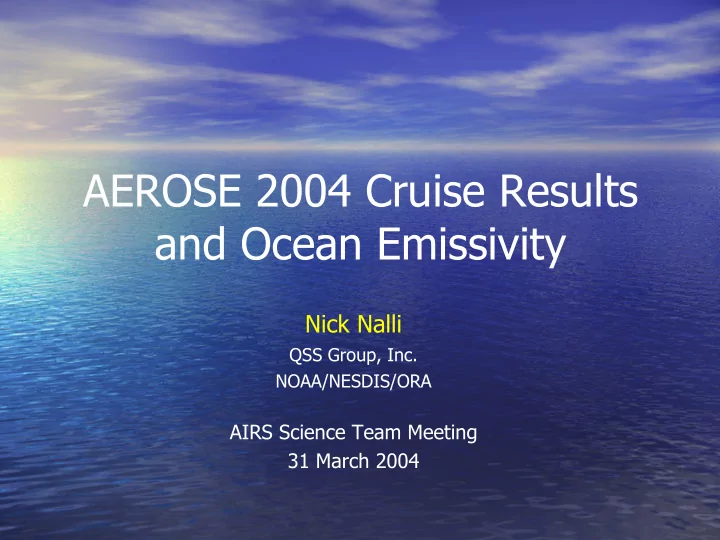

AEROSE 2004 Cruise Results and Ocean Emissivity Nick Nalli QSS Group, Inc. NOAA/NESDIS/ORA AIRS Science Team Meeting 31 March 2004
AEROSE 2004 Overview • The Aerosol and Ocean Science Expedition (AEROSE) was conducted onboard the NOAA Ship Ronald H. Brown (RHB) in the tropical North Atlantic Ocean from 29 February to 26 March 2004 in collaboration with the NOAA Center for Atmospheric Sciences (NCAS) at Howard University. • The NOAAS RHB set out from Bridgetown, Barbados traveling eastward toward Africa. Near the African coast, the ship turned north toward the Grand Canaries. After a port-of-call in Las Palmas, Gran Canaria, the ship then returned to San Juan, Puerto Rico on 26 March. • Atmospheric and oceanographic measurements were acquired with a compliment of in situ and remote sensing sensors under dust and non-dust conditions. • The eastward trans-Atlantic leg of the cruise included oceanographic stations for subsurface CTD sampling and XBT profiling. • The cruise included educational component (student participation, courses taught underway, ship tours while in ports). • A follow-on Saharan dust cruise is in the RHB draft allocation plan for Summer 2005.
AEROSE Data of Interest • Marine Atmospheric Emitted Radiance Interferometer (M-AERI) – Ship-based FTS designed to sample atmospheric and surface IR emissions – Algorithms derive skin SST (<0.1 K), emissivity and BL profiles • Calibrated InfraRed In situ Measurement System (CIRIMS) – Reduced complexity & cost; autonomous – Designed solely for providing accurate radiometric SST ground truth • Vaisala RS80/90 RAOBs – ~3-Hourly throughout cruise, including AIRS overpasses • Microtops handheld sunphotometer – Surface based measurements of aerosol optical depth (AOD) • Standard oceanographic/meteorological surface data from ship
M-AERI and CIRIMS Legacy: 1996 Combined Today: 2004 Aerosol and Ocean Science Expedition (AEROSE) Sensor Program (CSP) U. Miami M-AERI & UW/ NOAA Ship Ronald H. Brown NOAA Ship Discoverer APL CIRIMS Bridgetown, Feb 04 Pago Pago, March 96 UW-Madison M-AERI Prototype Onboard NOAAS Discoverer CSP Photo credits: B. Osborne
SST Ground Truth for Cal/Val • IR and MW detectors remotely sense radiometric “skin” temperature • Skin SST differs from “bulk” SST measured in situ (e.g., buoys ~ − 0.1 ±1 K) • This uncertainty imposes significant limits upon satellite cal/val efforts – radiometric ground truth is thus essential • M-AERI and CIRIMS are examples of shipboard instruments designed to obtain accurate radiometric SST
AEROSE M-AERI vs. CIRIMS • M-AERI and CIRIMS are two distinctly different IR instruments with completely different algorithms • During AEROSE, significant surface winds yielded a skin SST systematically cooler than the 2 m in situ measurement
Dust Event
Dust Event 17:00 UTC, 6 March 04 11:00 UTC, 7 March 04
AEROSE 3-Hourly RAOBs
Ocean Emissivity/Reflectivity
Radiative Transfer Equation (RTE) c loud free, non-scattering, azimuthal symmetry
Ocean Surface IR Emissivity and Reflectance • Radiance emissivity models (e.g., Wu and Smith, 1997; Watts et al., 1996; Masuda et al., 1988) have been derived from Cox-Munk wave slope statistics. • Lookup tables (LUT) of model emissivity can be used in radiative transfer modeling. • Quasi-specular reflectance of atmospheric radiance is a more challenging problem: – Surface is neither specular nor Lambertian, but quasi-specular – Thus, depends upon the hemispherical radiance distribution – Using 1 − Є leads to systematic underestimation of radiance in microwindow channels – This systematic error is significant for SST applications requiring high accuracy
Quasi-Specular Reflection Model • Kirchhoff Approximation: Surface waves have dimensions large compared to IR λ (geometrical optics limit) • Fresnel Reflectivity: Known from observed refractive indices • Facet Model: Cox-Munk mean square slope statistics dependent upon local surface wind speed From Nalli et al. (2001) • Transform slope coordinates to local zenith and azimuth angle Cartesian coordinate system for a wave facet under the Kirchhoff approximation • Account for wave blocking and reflected emission consistent with the emissivity model
Reflected Radiance The reflected IR radiance from the atmosphere is then given by This equation essentially describes the reflected radiance as the ensemble effect of rays reflected from all possible slopes into the field of view of the observer.
Reflection Diffusivity-Angle For convenience in retrievals, computation is greatly reduced by introducing a reflection diffusivity-angle (Nalli et al., 2001) which leads to from which can be determined by finding the zeros of the equation. A fast transmittance model can be used to calculate LUT for a range of wavenumbers, wind speeds and atmospheric opacities, i.e.,
Behavior of • implies an enhancement of reflected intensity • Reflection becomes specular with decreasing winds • For dry atmosphere, always • Similarly for moist atmosphere (right plots), except at θ 0=70o, where for non-zero winds
M-AERI Ocean Surface Spectra • Non-unity emissivity signal is apparent • Water vapor absorption lines appear as “spikes” • The specular model underestimates the observation in microwindows by From Nalli et al. (2001) ~0.2 K Model calculations versus M-AERI observation for 550 view angle at 22:18 UTC, 17-Mar-96.
Model versus M-AERI 17-Mar-96, 22:18 UTC (2.1 S, 179.9 W) 09-Apr-96, 22:28 UTC (7.3 N, 172.6W) V = 4.9 m/s; roll = − 1.080 V = 13.7 m/s; roll = − 0.450
Findings from CSP • Specular reflection underestimates the observed brightness temperature by as much as 0.4 K at larger zenith angles. • Reflection-diffusivity model improves agreement by a factor of ~2 • The remaining deficit was partially due to the lower boundary of the uplooking model truncated at 1000 hPa • More validation against M-AERI is desirable: AEROSE…
Recommend
More recommend